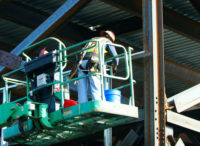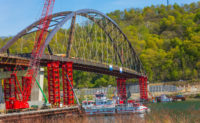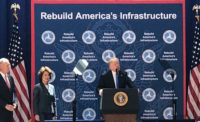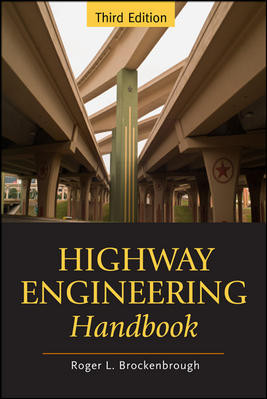The Trump Administration
Trump Ends Infrastructure Talks Before They Begin. Now What?
The president's abrupt exit from a meeting with Pelosi and Schumer leaves a $2-trillion plan hanging.

President Donald Trump speaks in the Rose Garden of the White House on May 22, 2019 in Washington, DC., after abruptly ending a meeting with Democratic leaders on infrastructure. Photo: Oliver Contreras/SIPA USA
The blow-up of negotiations between President Trump and top congressional Democrats over a major infrastructure investment plan has probably sidetracked a comprehensive, multi-sector bill, at least for now.
But industry officials maintain that infrastructure legislation isn’t dead and see a couple of possible paths forward. Some say congressional committees will pursue multiple bills, each narrowly targeted to a particular market sector.
“Sadly, it appears political theatrics won the day.”
–Dave Bauer, American Road & Transportation Builders Association president and chief executive officer
Another avenue, they say, is a new highway-transit reauthorization bill, due by the end of September 2020, which could be a vehicle for provisions affecting non-transportation segments, too.
House Speaker Nancy Pelosi (D-Calif.), Senate Minority Leader Chuck Schumer (D-N.Y.) and other senior Democrats had gathered at the White House on the morning of May 22 for a scheduled meeting with Trump to discuss options for funding a major multi-year infrastructure plan pegged at $2 trillion.
It was a follow-up to an April 30 session during which, Pelosi and Schumer said, they and Trump agreed to work on the $2-trillion concept. Both sides characterized that meeting as productive.
But the new session ended nearly as soon as it began. After Trump entered the room, he said to reporters later, “I told Senator Schumer and Speaker Pelosi, ‘I want to do infrastructure. I want to do it more than you want to do it.’” He also said, “But you know what? You can’t do it under these circumstances. So get these phony investigations over with.” Then he walked out.
Another development that appeared to set Trump off was Pelosi's comment earlier that morning after a meeting of House Democrats that they believe the president "is engaged in a cover-up."
Senator Schumer Answers
Schumer dismissed Trump’s statement that the congressional probes were the reason for shutting down the meeting. Schumer said at a press conference, “Hello, there were investigations going on three weeks ago when we met and he still met with us.”
“Sadly, it appears political theatrics won the day,” said Dave Bauer, American Road & Transportation Builders Association president and chief executive officer.
But Bauer noted that needs in the largest infrastructure sector, highway and transit, remain daunting, with 235,000 bridges needing repairs or upgrades and the Highway Trust Fund still “in a world of financial hurt.”
Steve Hall, American Council of Engineering Companies senior vice president for advocacy and external affairs, said in an interview that the developments were “surprising and disappointing.” But he adds, “We can’t take our eye off the ball. This is we hope a temporary setback.”
Hall says Congress needs to focus on completing infrastructure measures by the end of the year. He adds, “And I think if that process continues—and is not interrupted by what happened today—when tempers cool and we can get back to serious discussion, we can get this moving again.”
With the $2-trillion concept up in the air, infrastructure advocates are looking at other options.
DeFazio's multiple-bill approach
House Transportation and Infrastructure Committee Chairman Peter DeFazio (D-Ore.), who attended the White House meetings, said afterwards, “Despite the disappointing outcome of today’s meeting, I remain committed to working in a bipartisan manner to move our infrastructure into the 21st Century, because the cost of inaction is too great.”
DeFazio said he would work to move “individual pieces of legislation that will make a difference” and a surface transportation reauthorization bill, too.
Sean O’Neill, Associated General Contractors of America vice president for congressional relations and infrastructure advancement, noted in an interview that DeFazio’s committee already has had some success.
On May 8, the panel approved a measure to let Congress spend more of the annual revenue flowing into the Harbor Maintenance Trust Fund and to spend down more of the fund’s $9.3-billiion balance. The fund pays for port dredging projects.
O’Neill says, “I think that there’s going to be an attempt still to do pieces of infrastructure legislation.” He adds, “Whether that all comes together in the form of a comprehensive bill remains to be seen.”
Eyes on FAST Act Successor
The surface transportation bill is a must-pass measure and it has a hard deadline of Sept. 30, 2020. That’s when the current statute, the 2015 Fixing America’s Surface Transportation, or FAST, Act, is due to expire.
If Congress misses that deadline, Bauer observes, state transportation agencies could be facing a 40% reduction in funding, beginning in 2021.
Hall thinks that a comprehensive multi-sector infrastructure measure is “still a possibility.” But he adds, “The FAST Act reauthorization, I think…is going to be the thing that drives this, the engine on the train.”
If the highway-transit proposal advances on Capitol Hill, Hall says, “Then it becomes a question of what additional pieces can we add to this,” with water infrastructure, buildings and energy among the possible add-ons.
The highway and transit funding cutoff is a strong incentive to lawmakers to get a FAST Act replacement passed by the 2020 deadline, but its approval isn’t a slam dunk. One industry source, who asked for anonymity, said in an interview that Congress would need to find substantial additional revenue for a new five-year bill that just continues current funding levels. “There is still an over-$100-billion funding gap,” the source says.
Another question is whether Congress will push to act on the highway-transit measure this year or in the deadline year of 2020.





